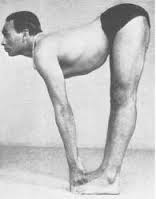
The other night I was subbing a class and asked some of the students if they had a home practice. These were students who have been practicing for years, and their responses were a bit surprising. “I don’t know which poses to do,” one said. “I prefer just doing yoga in the studio,” another said.
I am finding that not practicing at home because of these two reasons is very common. Doing yoga without a teacher is very much like studying Spanish for 10 years in a classroom and being asked by someone from Spain where the bathroom is and drawing a complete blank. And then when the Spanish guy leaves and finds the bathroom on his own, you come up with a beautifully crafted sentence with agreeing tenses on how to find the loo.
Making a jump from studio practice to home practice is tantamount to that scene in 2001, A Space Odyssey where the caveman throws the bone in the air and it jump cuts to a large spaceship. You get a much richer experience trying it on your own! I remember when I started supplementing my classes with a home practice, my yoga experience increased exponentially.
A bit of history about my own practice. I was one of those people who picked up “Light On Yoga” got inspired, and tried the courses at the back of the book…the kind with 40-50 poses for a single practice. I remember those days. I would blast Coltrane while trying to do Parsvottanasana which I thought was a backbend in stage I because Iyengar’s chest was so open.

Of course Parsvottanasana is actually a forward bend and the prep as seen above is to open the chest. To get to my point, I had to do the manual labor of those courses and fail miserably in my own practice before I could appreciate what my teacher was actually trying to tell me. But a magical thing happened while I was trying out those courses and could not make it past week 16 in Light On Yoga…I developed some type of internal discernment about how to sequence poses.
One of my top posts is to do Supta Padangusthasana if you cannot think of any other pose to start your practice. To develop that idea a bit further for seasoned students, I would start doing a home practice by first selecting a clan of poses on which to focus. There are Utthishta Sthiti (standing poses), Paschima Pratana Sthiti (forward bends), Purva Pratana Sthiti (Backbends), Upavistha Sthiti (seated poses), Viparita Sthiti (Inversions), Udara Akunchana Sthiti (abdominal poses), and Visranta Karaka (restorative poses). Each clan has it’s own personality and effects.
Standing poses are vigourous and are the “donkey work” of yoga. It is said that raw beginners should do at least 6 months from this clan before proceeding if their practice is regular. I would say more like 2 years for the practitioner who does yoga twice a week.
Forward bends are considered “cooling” as they calm the nervous system when done properly. However, if you have tight hamstrings, parsvottanasana (see above) is anything but “cooling” and that is why you need the prerequisite foundation of standing poses.
Seated poses are “quieting” and allow the practitioner to learn how to build time in poses. With a strong earth element in the pose, they ground the practitioner. With experience, one later uses this clan for pranayama and dhyana.
Backbends are approached with caution. The are “heating” and energizing, but you can blow a gasket (or a vertebrae) if you don’t respect this clan. It is best to start with the “baby back bends” like salabhasana before getting too adventurous.
Inversions are also approached with care. They have an assertive effect on blood circulation. If you have any blood pressure issues, you should consult your teacher and your doctor. It is also not advised for women not to do this while menstruating. Once that is out of the way inversions should be a daily practice and advised to do in the evening as they contract many of the ill effects of sitting throughout the day.
Abdominal poses can be treated more like a garnish, more than an entree and can be interspersed between poses in certain sequences. These are poses like Paripoona Navasana, and Supta Padangusthasana. However, I have been to many classes where all we did was abdominal poses.
Lastly, restorative poses are done for several reasons. I like to think of them as “repairing” myself for any mistakes I made in my other clans. In the Iyengar style, women who are menstruating should adhere to restorative practice during their cycle and omit inversions. Yoga in the West nowadays is turning into a glorified aerobics craze, and this clan allow the practitioner to start focusing on the inward aspects of the practice.
To start one’s own practice, I would chose a clan according to experience and energy level. Yoga is an art, a science, and a philosophy. By doing your own practice, you practice the art. You construct what you need to do. You explore concepts that you are curious about. You will fail. You will succeed.






































